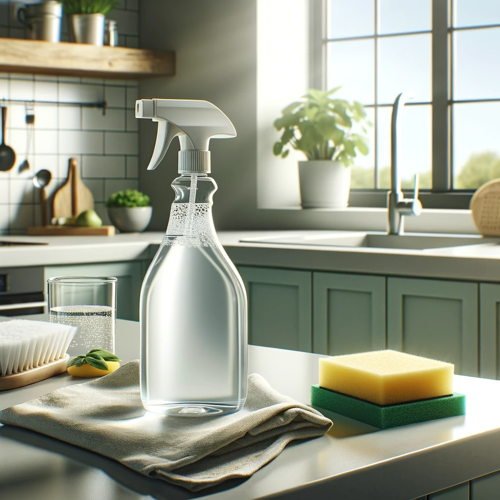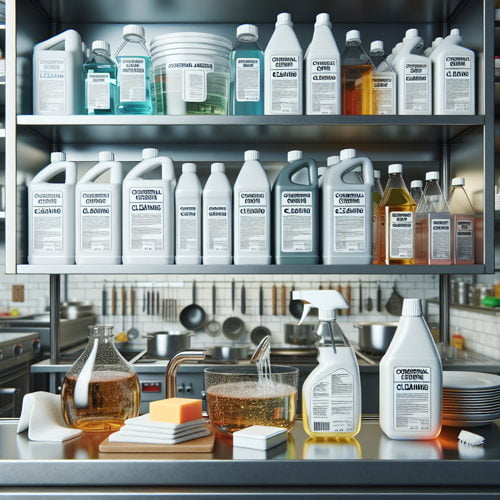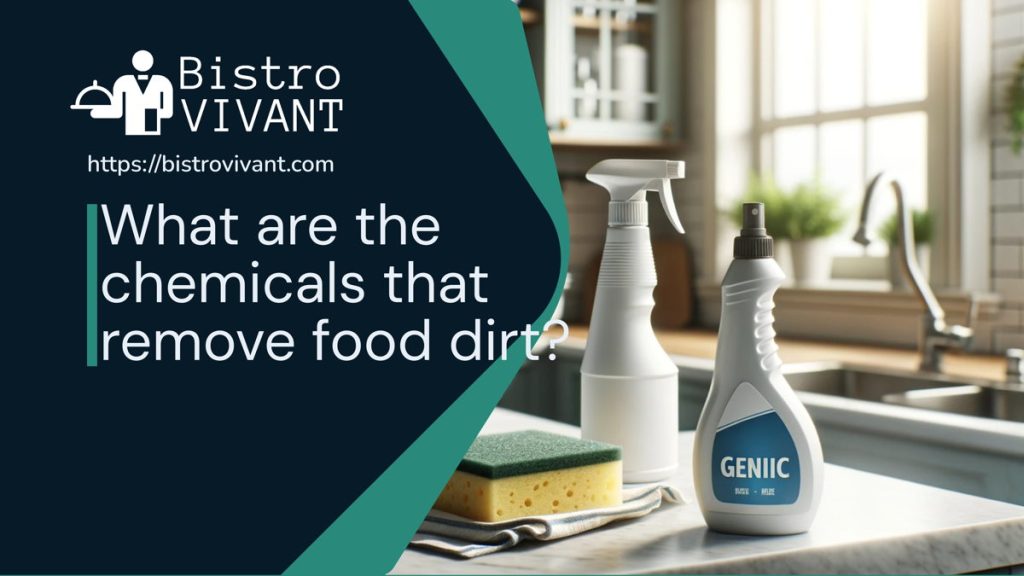A clean and hygienic kitchen is the heart of every home. Yet, it’s no secret that the daily activities of cooking, eating, and food preparation can leave behind a trail of mess and food residues, often referred to as food dirt.
To maintain a pristine kitchen environment, it’s essential to understand and utilize the right chemicals and cleaning agents to tackle these persistent stains and particles effectively. In this article, we will delve into the world of cleaning chemistry and explore various chemicals that remove food dirt.
What is food dirt?
“Food dirt” is a casual term used to describe the residue, crumbs, spills, and food particles that accumulate on surfaces in a kitchen or dining area as a result of cooking, eating, and food preparation activities. It refers to the remnants of food that can be left behind on countertops, dishes, utensils, kitchen appliances, and dining tables.
Food dirt can come in various forms and may include:
- Crumbs: Small pieces of bread, crackers, or other baked goods that break apart and scatter on surfaces.
- Sauces and Spills: Drips or splatters of sauces, gravies, condiments, and beverages that may leave sticky or stained spots.
- Grease and Cooking Oils: Splatters and residue from frying or cooking with oils can leave surfaces feeling greasy.
- Food Residue: Leftover bits of food that adhere to dishes, pots, pans, and utensils after cooking and eating.
- Food Particles: Tiny bits of vegetables, fruits, or other food items that can fall onto countertops or tables during food preparation.
- Food Odors: Lingering smells from cooked or prepared food can attach themselves to surfaces.
Food dirt is a natural consequence of meal preparation and consumption, and it’s essential to clean it regularly to maintain a hygienic and pleasant kitchen environment. Using the right cleaning agents and techniques can help effectively remove food dirt and prevent it from accumulating.

Exploring Effective Chemicals for Removing Food Dirt
Dish Soap: The Kitchen Workhorse
When it comes to removing food dirt from dishes, utensils, and cookware, there’s a true kitchen workhorse that stands out: dish soap. This household staple is not just for washing dishes; it’s a versatile cleaner that can tackle a wide range of kitchen cleaning tasks.
Dish Soap Explained: Dish soap works by breaking down and emulsifying grease and food residues, making them easier to wash away. It contains surfactants that lower the surface tension of water, allowing it to penetrate and remove oils and fats efficiently.
Using Dish Soap Effectively:
- For everyday dishwashing, apply a small amount of dish soap to a sponge or dishcloth and scrub dishes under running water.
- To remove stubborn food residues from pots and pans, soak them in hot, soapy water before scrubbing.
- Dish soap can also be used to clean kitchen surfaces and appliances. Dilute it in water to create a gentle cleaning solution.
Baking Soda: The Natural Cleaner
Baking soda, often found in the kitchen pantry, is another fantastic cleaning agent for removing food dirt. Its mild abrasive nature makes it a powerful ally in the battle against kitchen grime.
Baking soda’s cleaning power: The abrasive texture of baking soda allows it to scrub away food particles and stains without scratching surfaces. It’s particularly effective on surfaces like countertops, dishes, and stovetops.
Applications in the Kitchen:
- Sprinkle baking soda on a damp sponge or cloth to clean dishes and remove stubborn food residues.
- Create a paste by mixing baking soda with water and applying it to stained surfaces like cutting boards. Allow it to sit before scrubbing.
- Use baking soda to deodorize your refrigerator by placing an open container inside.

White Vinegar: The Multi-Purpose Solution
White vinegar is a kitchen staple that serves multiple purposes, including its role as an effective food dirt remover. Its acidity helps break down food stains and can tackle various kitchen cleaning tasks.
The Power of White Vinegar: White vinegar’s acidity allows it to dissolve and loosen food dirt and stains. It also acts as a natural deodorizer, eliminating odors that can linger in the kitchen.
Cleaning with White Vinegar:
- Mix equal parts white vinegar and water to create a versatile cleaning solution.
- Use this solution to wipe down kitchen countertops, sinks, and appliances.
- Run a cycle with white vinegar in your dishwasher or coffee maker to remove mineral deposits and odors.
Citrus-Based Cleaners: Fresh and Effective
Citrus-based cleaners bring a delightful twist to kitchen cleaning. These cleaners harness the natural degreasing properties of citrus oils and leave behind a refreshing scent.
Citrus Power Explained: Citrus-based cleaners contain natural citrus oils, such as those from lemons or oranges. These oils contain compounds that effectively break down grease and grime, making them excellent choices for removing food dirt.
Perfect Kitchen Uses:
- Use citrus-based cleaners to wipe down kitchen surfaces, stovetops, and appliances.
- Their fresh scent can help eliminate cooking odors that often linger in the kitchen.
Enzyme Cleaners: Breaking Down Organic Matter
Enzyme cleaners offer a unique approach to removing food dirt by utilizing enzymes to break down organic matter, including food residues and stains.
Enzymes at Work: Enzyme cleaners contain specific enzymes that target and break down proteins, starches, and fats found in food particles. This enzymatic action makes them highly effective in removing stubborn food stains and odors.
Application in the Kitchen:
- Enzyme cleaners are ideal for removing food stains on fabrics, such as tablecloths or kitchen towels.
- They can also be used to clean pet food dishes and litter boxes, as they effectively break down organic matter.

Hydrogen Peroxide and Oxygen Bleach—Stain Removal
Hydrogen peroxide and oxygen bleach are powerful allies when it comes to removing stubborn food stains. They offer effective stain removal without the harshness of chlorine bleach.
Hydrogen Peroxide’s Stain-Fighting Properties: Hydrogen peroxide is a mild bleach and disinfectant. It’s particularly useful for removing food stains from fabrics and some surfaces without causing discoloration.
Using hydrogen peroxide:
- Dab hydrogen peroxide on food stains on clothing or tablecloths before washing.
- Mix it with water to create a solution for cleaning cutting boards and countertops.
Oxygen Bleach as a Gentle Alternative: Oxygen bleach, often sold as a powder, is a milder alternative to chlorine bleach. It can effectively remove food stains and whiten surfaces without the harsh fumes and risks associated with chlorine bleach.
Applications in the Kitchen:
- Add oxygen bleach to your laundry to remove food stains from kitchen towels and cloth napkins.
- Use it to clean and whiten grout between tiles or surfaces stained by food.
Ammonia: A Powerful Degreaser
Ammonia-based cleaners are known for their potency in cutting through grease and grime. They can be indispensable for tackling tough food dirt in the kitchen.
Understanding Ammonia’s Power: Ammonia’s high alkalinity and degreasing properties make it a potent cleaner. It can effectively dissolve greasy residues that accumulate in cooking areas.
Safety Precautions:
- Use ammonia-based cleaners in a well-ventilated area to avoid inhaling fumes.
- Always follow the manufacturer’s instructions for proper use and dilution.
Where to use ammonia:
- Ammonia-based cleaners are excellent for cleaning stove burners, oven racks, and range hoods.
- They are also useful for removing sticky messes that adhesive labels leave behind.

Commercial Kitchen Cleaners: Convenience and Effectiveness
Commercial kitchen cleaners are formulated specifically for the demands of kitchen cleaning. They often contain a combination of surfactants, solvents, and degreasers to tackle tough stains.
Benefits of Commercial Cleaners:
- Commercial kitchen cleaners are convenient and ready-to-use.
- They are designed to remove food dirt, grease, and grime effectively.
- These cleaners are available in various formulations, including antibacterial options.
Choosing the Right Cleaner:
- Read product labels to find a cleaner suitable for your specific cleaning needs.
- Follow the manufacturer’s instructions for the best results.
- Consider eco-friendly or natural alternatives if you prefer environmentally conscious options.
Conclusion
A clean and well-maintained kitchen is a reflection of a healthy and organized household. Understanding the power of various chemicals and cleaning agents can help you efficiently remove food dirt and maintain a hygienic environment.
Whether you choose natural solutions like baking soda and white vinegar or opt for commercial cleaners, remember to follow safety guidelines and use these chemicals judiciously. By incorporating these tools into your cleaning routine, you can enjoy a spotless kitchen and a comfortable cooking experience.
Additional Tips
- Regular cleaning and maintenance can prevent the buildup of food dirt and make cleaning tasks more manageable.
- Always test a small, inconspicuous area when using a new cleaning agent to ensure it won’t damage the surface.
- Consider using eco-friendly and non-toxic cleaning agents if you have concerns about chemical exposure.
 https://bistrovivant.com is a participant in the Amazon Services LLC Associates Program, an affiliate advertising program designed to provide a means for website owners to earn advertising fees by advertising and linking to Amazon (.com,.co.uk,.ca, etc.) and any other website that may be affiliated with the Amazon Service LLC Associates Program. As an Amazon Associate, I earn from qualifying purchases.
https://bistrovivant.com is a participant in the Amazon Services LLC Associates Program, an affiliate advertising program designed to provide a means for website owners to earn advertising fees by advertising and linking to Amazon (.com,.co.uk,.ca, etc.) and any other website that may be affiliated with the Amazon Service LLC Associates Program. As an Amazon Associate, I earn from qualifying purchases.

